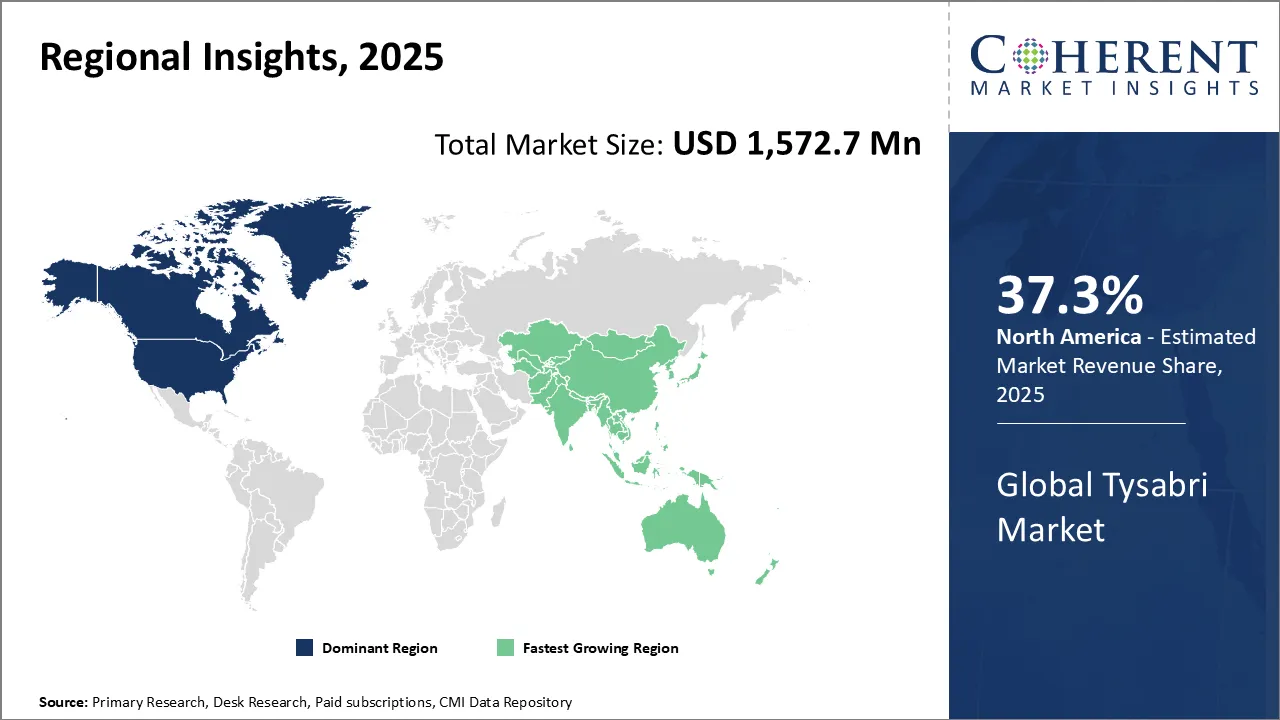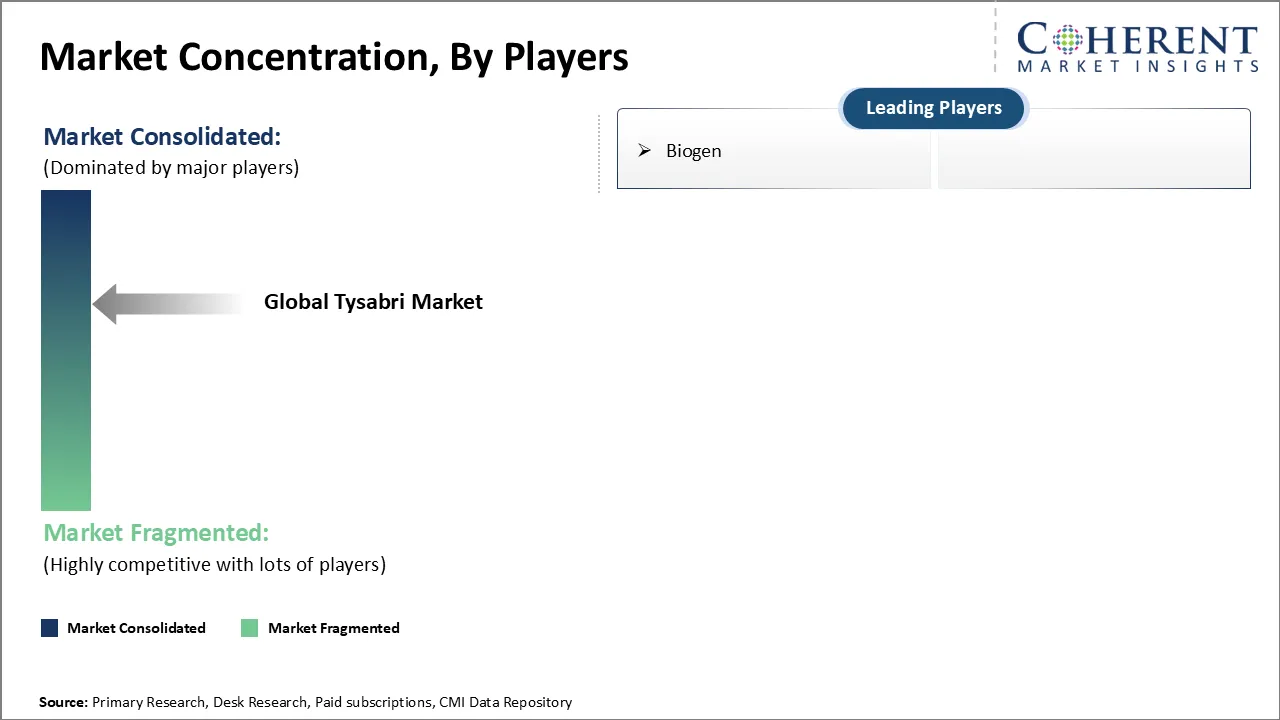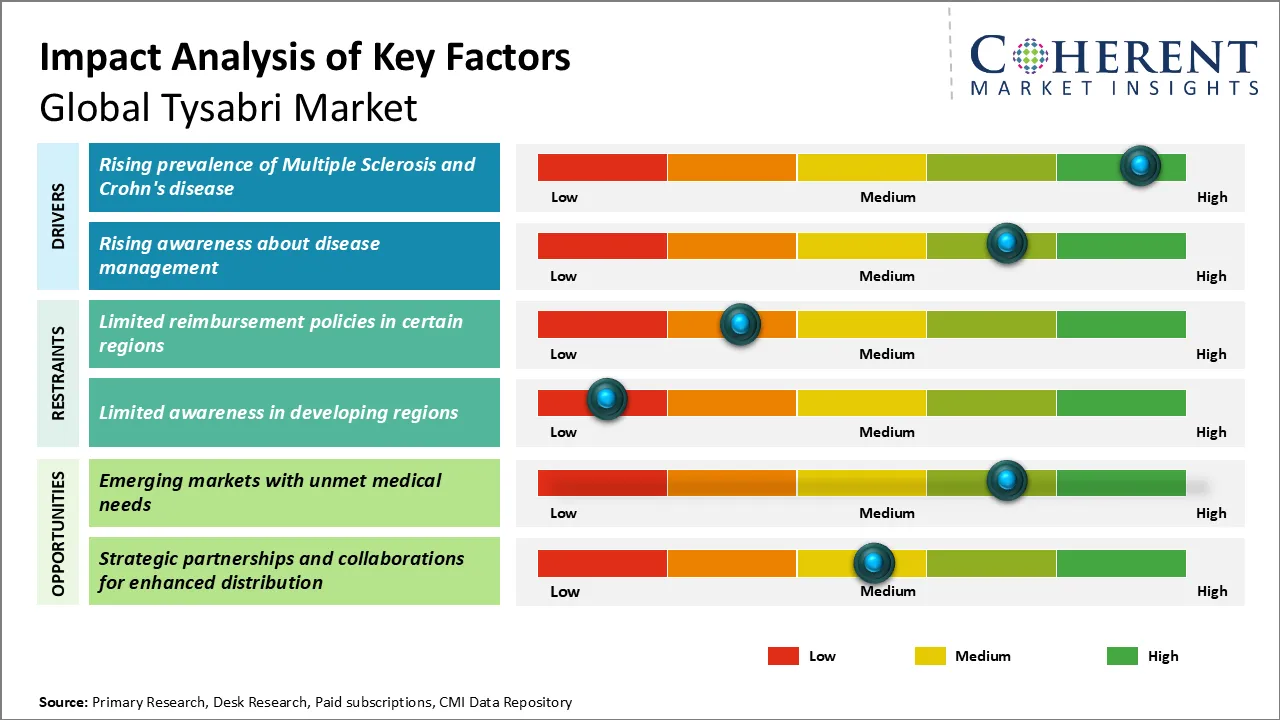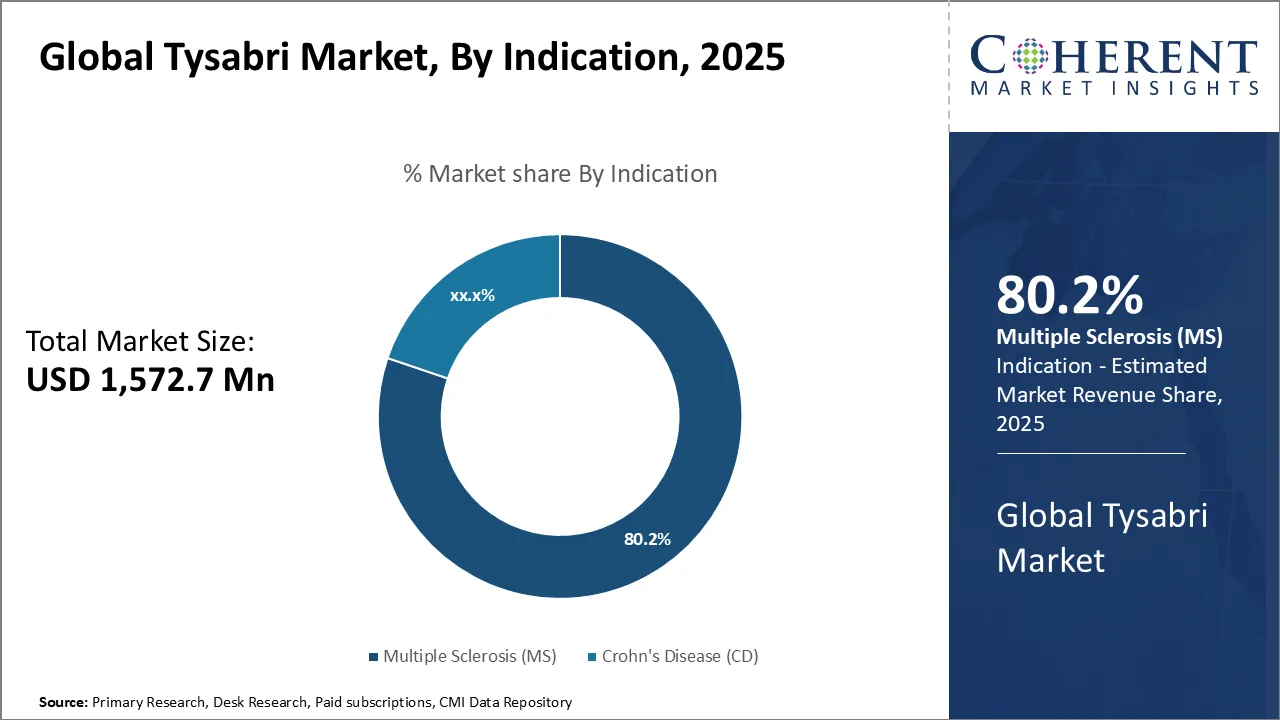Global Tysabri Market Size and Forecast – 2025 to 2032
The Global Tysabri Market is estimated to be valued at USD 1,572.7 Mn in 2025 and is expected to reach USD 1,120.3 Mn by 2032, exhibiting a compound annual growth rate (CAGR) of -4.7% from 2025 to 2032. This decline indicates a significant contraction in market size over the forecast period, reflecting shifts in demand, competitive dynamics, or potential technological disruptions impacting the overall valuation.
Key Takeaways of the Global Tysabri Market:
- The Multiple Sclerosis (MS) segment is expected to dominate the global Tysabri market, accounting for 80. 2% of the market share in 2025.
- Hospitals are projected to hold the largest share of the Tysabri market at 34. 2% in 2025, due to their ability to provide specialized infusion therapies.
- North America is expected to lead the market, holding a share of 37. 3% in 2025. Asia Pacific is anticipated to be the fastest-growing region, with a market share of 25.2% in 2025.
Market Overview:
The Tysabri market trend highlights a notable decrease driven by several factors, including evolving consumer preferences and the rise of alternative solutions that may be overshadowing traditional offerings. Additionally, regulatory challenges, pricing pressures, and innovation gaps could be contributing to the downward trajectory. Stakeholders are likely to focus on product differentiation and exploring emerging markets or adjacent sectors to mitigate the impact of this negative growth trend.
Currents Events and their Impact
|
Current Events |
Description and its impact |
|
Advancements in Drug Delivery |
|
|
Rising Competition from Biosimilars |
|
Uncover macros and micros vetted on 75+ parameters: Get instant access to report
Tysabri Market Insights, By Indication - Multiple Sclerosis (MS) leads owing to increasing prevalence and expanding treatment options
The Multiple Sclerosis (MS) segment is expected to dominate the global Tysabri market with a share of 80.2% in 2025 primarily due to the rising global incidence and awareness of this chronic autoimmune disease that affects the central nervous system. MS often leads to a broad spectrum of neurological symptoms, necessitating long-term management through effective therapies, which makes Tysabri a disease-modifying therapy an essential treatment option for many patients.
One of the key drivers behind the prominence of the multiple sclerosis segment is the growing prevalence of MS worldwide, especially in regions with better healthcare infrastructure and diagnostic capabilities. Improvements in diagnostic technology, such as enhanced MRI techniques, allow for earlier and more accurate detection, resulting in increased identification of MS cases and subsequently, greater demand for disease management medications like Tysabri. The complex pathology of MS, characterized by inflammatory demyelination and neurodegeneration, creates a continuous need for advanced treatment options that can modify disease progression and reduce relapses, positioning Tysabri as a preferred choice among healthcare providers.
Tysabri Market Insights, By End User - Hospitals dominate driven by intensive care infrastructure and comprehensive treatment capabilities
The hospitals segment is expected to hold the largest share of 34.2% in 2025 based on end users within the global Tysabri market, primarily due to their capacity to provide specialized home infusion therapies and comprehensive care required for managing conditions treatable with Tysabri. As Tysabri administration typically involves intravenous infusion under strict medical supervision, hospitals are the optimal setting where patients can receive such complex treatments safely and efficiently.
One of the fundamental factors driving the hospital segment’s dominance is their well-established infrastructure for delivering infusion therapies. Hospitals are equipped with the necessary medical technology, trained healthcare professionals, and emergency support systems to manage potential infusion-related adverse events, which can be critical considering the immunomodulatory nature of Tysabri. This safety assurance encourages physicians to prefer hospital settings for initiating and maintaining Tysabri therapy.
Pricing Analysis of Tysabri Market
- The pricing of Tysabri in 2025 varies significantly across different countries due to differences in healthcare systems, production costs, and market conditions. In the U.S., the typical out-of-pocket cost for a 300 mg/15 mL vial is approximately USD 9,124.18, while prices in countries like Mexico, Canada, and Saudi Arabia range from USD 3,090.36 to USD 3,491.43. Countries such as Australia and India offer significantly lower prices at USD 983.46 and USD 1,266.59, respectively. European countries like Germany and the U.K. reflect mid-range prices around USD 3,044.03 and USD 1,288.03. This pricing discrepancy can be attributed to local healthcare policies, insurance coverage, market demand, and government pricing controls. Additionally, the introduction of biosimilars and evolving competition is expected to drive prices lower, particularly in markets where generics are becoming more prevalent.
- Looking forward, Tysabri’s price is expected to experience varying levels of increase and decrease by 2032, depending on regional trends and the entry of biosimilars into the market. The U.S. Tysabri market is projected to see a 20-25% price increase, while several European countries, including Germany, Italy, and Spain, are anticipating price increases of 20-30%. In contrast, countries like Nigeria and Saudi Arabia are likely to see moderate price increases of 15-20%. The potential for price reductions due to biosimilar competition and the development of new biologics could lead to a significant decrease in Tysabri’s price by up to 50% in some regions. Additionally, pricing will be affected by patent expiration and the introduction of cost-control measures by governments, particularly in Europe, where stricter pricing regulations are more common.
Regional Insights:

To learn more about this report, Download Free Sample
North America Tysabri Market Analysis and Trends
North America Tysabri market continues to face slow growth with an estimated share of 37.3% in 2025 due to increasing competition and the emergence of alternative treatments. The region’s mature industrial ecosystem, extensive R&D investments, and robust government support have traditionally driven the market dominance. While these companies continue to contribute to product development and maintain strong distribution networks, the overall market is being hindered by stricter regulatory requirements and the shifting preference toward oral therapies and newer biologics. Regulatory policies focused on quality and sustainability may help foster incremental improvements in the market, but substantial growth remains unlikely in the near future. However, rising awareness about multiple sclerosis (MS) and its treatment options, driven by advocacy groups, social media campaigns, and educational initiatives, is helping to increase early diagnosis and treatment adoption.
For instance, in March 2025, Snap Inc., one of the technology companies based in the U.S., in partnership with the National Multiple Sclerosis Society (NMSS), launched an interactive augmented reality (AR) campaign to raise awareness about multiple sclerosis (MS) in the U.A.E. The campaign, part of MS Awareness Month, features Snap’s first-ever regional step counter Lens, encouraging users to complete a walking challenge. At each milestone, participants unlock key facts about MS, including symptoms, prevalence in the U.A.E, and the importance of early diagnosis.
Asia Pacific Tysabri Market Analysis and Trends
The Tysabri market in the Asia Pacific region, while experiencing the fastest growth compared to other regions with an estimated share of 25.2% in 2025, is also showing signs of slow expansion due to rising competition and evolving healthcare preferences. Countries, such as China, India, Japan, South Korea, and Southeast Asia, have made significant investments in infrastructure and industrial modernization, which have driven initial market growth.
Government initiatives like “Made in Asia” and innovation-friendly policies have made it easier for both domestic and international companies to enter, but these same policies have fostered a crowded and competitive environment. The region’s market is further constrained by shifting preferences towards less invasive treatments, trade challenges, and a focus on more cost-effective solutions. While opportunities for market expansion remain, the overall growth trajectory is expected to remain slow, with a negative CAGR due to these challenges.
Tysabri Market Outlook for Key Countries
U.S. Tysabri Market Trends
The U.S. Tysabri market is facing a challenging environment with slow growth and a negative CAGR, largely due to increasing competition from biosimilars like Tyruko and newer oral treatments. While the prevalence of autoimmune diseases, such as multiple sclerosis and Crohn’s disease, continues to drive the demand for Tysabri, the market is increasingly influenced by the rising adoption of alternative therapies. Advancements in personalized medicine, improved biomarker identification, and the development of new treatment strategies have enhanced patient outcomes, but concerns over the risk of progressive multifocal leukoencephalopathy (PML) require strict patient monitoring, limiting its widespread use.
For instance, in June 2024, according to the American Academy of Neurology, a recent study published analyzed the annual incidence of multiple sclerosis (MS) from 2014 to 2020 in a large U.S. healthcare system. The study found an overall incidence rate of 21.57 per 100,000 person-years, with the highest rate recorded in 2015 (26.49) and the lowest in 2020 (17.48). The annual percentage change in incidence was −5.07%, indicating a declining trend in MS cases.
U.K. Tysabri Market Trends
The U.K. Tysabri market is experiencing slow growth, influenced by the increasing adoption of biosimilars such as Tyruko, which offer cost-effective alternatives but have raised concerns about side effects in some patients. The regulatory landscape, with bodies like NICE continuing to evaluate Tysabri and its biosimilars, has contributed to a more cautious market environment. The recent approval of the subcutaneous (SC) formulation by the MHRA, while providing a more convenient treatment option for patients, has not significantly accelerated the market growth. While the SC formulation offers potential improvements in patient compliance, the shift towards alternative oral therapies and biosimilars has limited the overall growth potential in the U.K. Tysabri market.
In April 2021, the Medicines and Healthcare products Regulatory Agency (MHRA) approved a new subcutaneous (SC) formulation of Tysabri (natalizumab) for treating multiple sclerosis (MS). This approval follows the European Commission’s decision in March and applies to the U.K. and Ireland. The SC formulation, tested in the Phase 1 DELIVER and Phase II REFINE studies, has shown similar efficacy, pharmacokinetics, and pharmacodynamics to the intravenous (IV) version. Safety profiles were consistent with the established IV formulation, except for injection site pain
China Tysabri Market Trends
China Tysabri market, while experiencing rapid expansion in the past, is now seeing slow growth due to increasing competition and market saturation. Significant investments in industrial infrastructure and government-supported technology parks have initially boosted the market. However, the emergence of biosimilars and newer treatments with fewer safety concerns are slowing down the growth of Tysabri.
For instance, in February 2024, the National Institute of Standards and Technology reported that China outlined plans to drive industrial innovation through technological upgrades, focusing on transforming traditional industries that make up over 80% of manufacturing. The government will support leading enterprises to optimize innovation chains and collaborate with smaller businesses. Key initiatives include promoting high-quality development of industrial chains and establishing new innovation hubs, alongside strengthening foreign trade and investment.
Germany Tysabri Market Trends
Germany Tysabri market is experiencing slow growth due to the introduction of biosimilars like Tyruko, which offer cost-effective alternatives but face adoption challenges due to patient and healthcare provider preferences. While Tyruko has shown comparable efficacy and safety to Tysabri, competition from oral disease-modifying treatments is also influencing market dynamics. Regulatory bodies, such as IQWiG, are evaluating cost-effectiveness and reimbursement options, contributing to a cautious approach in the market. The overall trend in Germany reflects a balance between treatment efficacy, safety, and economic considerations.
Market Players, Key Developments, and Competitive Intelligence:

To learn more about this report, Download Free Sample
Key Developments:
- In March 2025, according to a study by University of Pittsburgh in the U.S., an analysis of two clinical trials suggests that Tysabri (natalizumab), developed by Biogen, may help delay disability progression in secondary progressive multiple sclerosis (SPMS) compared to Rebif (interferon beta-1a). While initial trial results failed to show significant benefits, accounting for a therapeutic lag revealed that Tysabri reduced the risk of disability progression by 58 percent over Rebif. The study found benefits in both active and non-active SPMS patients. These findings confirm Tysabri's potential to slow disability progression in SPMS, although further studies are needed.
- In February 2025, according to a study by the National Health Service England, Multiple sclerosis (MS) patients have reported severe side effects after being switched from Tysabri (natalizumab) to the cheaper Tyruko (natalizumab-sztn) as part of NHS England's cost-saving measures. Approximately 170 patients at Charing Cross Hospital in London have experienced complications, including relapses, mobility issues, fatigue, and pain. Some patients required hospitalization. Tyruko, manufactured by Sandoz, is a biosimilar to Tysabri, but concerns have arisen over its safety in these patients, who had been stable on Tysabri for years. NHS England has reported that these issues have only been observed at one hospital, though other patients have claimed similar reactions across multiple hospitals.
- In May 2024, new data from the Tysabri TOUCH program was presented at the 2024 Annual Meeting of the Consortium of Multiple Sclerosis Centers (CMSC). The data showed that while the number of cases of progressive multifocal leukoencephalopathy (PML) increased in the U.S. from 2009 to 2015, the rate has remained stable from 2016 to 2023. During this period, the number of people treated with Tysabri grew from 37,284 to 116,752. By 2023, 246 confirmed PML cases had been reported. These results support the effectiveness of updated PML risk management strategies. Tysabri is approved for treating multiple sclerosis but has a Boxed Warning for PML. The study was conducted by Biogen and Cytel Inc.
Market Report Scope
Tysabri Market Report Coverage
| Report Coverage | Details | ||
|---|---|---|---|
| Base Year: | 2024 | Market Size in 2025: | USD 1,572.7 Mn |
| Historical Data for: | 2020 To 2024 | Forecast Period: | 2025 To 2032 |
| Forecast Period 2025 to 2032 CAGR: | -4.7% | 2032 Value Projection: | USD 1,120.3 Mn |
| Geographies covered: |
|
||
| Segments covered: |
|
||
| Companies covered: |
Biogen |
||
| Growth Drivers: |
|
||
| Restraints & Challenges: |
|
||
Uncover macros and micros vetted on 75+ parameters: Get instant access to report
Tysabri Market Dynamics

To learn more about this report, Download Free Sample
Tysabri Market Driver - Rising prevalence of Multiple Sclerosis and Crohn’s disease
The rising prevalence of chronic autoimmune disorders such as Multiple Sclerosis (MS) and Crohn’s disease has historically driven the demand for Tysabri globally. However, with the market experiencing slow growth and a negative CAGR, this driver is now less impactful. MS, a neurological condition characterized by inflammation and damage to nerve fibers in the central nervous system, continues to see increasing diagnosis rates due to improved awareness and diagnostic techniques. Similarly, Crohn’s disease, an inflammatory bowel disease causing severe gastrointestinal symptoms, remains prevalent across many regions.
While Tysabri is known for its efficacy in reducing relapses in MS patients and managing moderate to severe Crohn’s disease, newer treatments and biosimilars are emerging with competitive pricing and fewer safety concerns. As a result, the chronic and debilitating nature of these diseases continues to expand the patient population. However, the shift toward more cost-effective and convenient therapies has dampened market demand for Tysabri. Consequently, the adoption of Tysabri is slowing, further reinforcing the trend of declining market growth.
In September 2022, according to Journal of Crohn's and Colitis, a recent study on Crohn’s disease found that the incidence rate was 9.9 per 100,000 person-years from 2007 to 2018, with high disease burden and a significant progression of disease behavior. Similarly, MS diagnosis rates are rising, partly due to improved awareness and diagnostic techniques. As the prevalence of these diseases increases, there is a growing patient pool seeking treatments like Tysabri, known for its efficacy in reducing relapses and managing moderate to severe cases. These trends reinforce the need for continuous innovation in treatment strategies to address the rising demand for effective therapies.
Tysabri Market Opportunity - Emerging Markets with Unmet Medical Needs
The rising prevalence of chronic diseases and genetic disorders in emerging markets, such as Latin America, Southeast Asia, and parts of Africa, creates a growing opportunity for Tysabri. However, these regions have traditionally faced barriers to accessing advanced biologic therapies due to factors like high treatment costs, limited healthcare infrastructure, and regulatory hurdles. As healthcare systems improve and government initiatives expand, the potential for biologic therapies like Tysabri to address these unmet medical needs increases.
For instance, in September 2024, data from Washington University in St. Louis highlighted the importance of Crohn’s & Colitis Awareness Week, which takes place from December 1-7, to raise awareness about the nearly 3 million Americans living with inflammatory bowel diseases (IBD), including Crohn’s disease. These chronic conditions significantly impact patients' quality of life. In emerging markets, similar initiatives are being launched to increase awareness of chronic diseases and disorders treatable by biologic therapies, thereby driving demand. Government healthcare schemes in countries like Brazil, India, and parts of Southeast Asia are gradually addressing cost and access issues, helping make treatments like Tysabri more accessible. Additionally, ongoing research efforts in these regions focus on enhancing diagnostics and personalized treatment options, leading to better outcomes for patients.
Analyst Opinion (Expert Opinion)
- The global Tysabri market is currently experiencing slow growth, with a negative CAGR, due to increasing competition from biosimilars and alternative therapies offering lower costs and fewer side effects. Key driving factors that previously supported the growth of Tysabri include its proven efficacy in treating multiple sclerosis (MS) and Crohn's disease, along with regulatory support and increasing demand for disease-modifying therapies. However, market dynamics have shifted with the rise of oral therapies and biosimilars like Tyruko, which have contributed to the slow growth trajectory. Opportunities still exist in personalized medicine and extended dosing protocols, but these are unlikely to offset the challenges posed by newer, more convenient treatment options.
- Relevant conferences such as the Consortium of Multiple Sclerosis Centers (CMSC) Annual Meeting and the European Committee for Treatment and Research in Multiple Sclerosis (ECTRIMS) have contributed valuable insights into the evolving treatment landscape. These events have fostered discussions on the future of MS therapies and advancements in drug delivery methods, which will influence the trajectory of the Tysabri market. Additionally, several initiatives in MS care, such as the introduction of biosimilars and novel treatment protocols, are expected to continue shaping the market. Despite these developments, the overall outlook for Tysabri remains cautious due to market saturation and competitive pressures.
Market Segmentation
- Indication Insights (Revenue, USD Mn, 2020 - 2032)
-
- Multiple Sclerosis (MS)
- Crohn’s Disease (CD)
- End User Insights (Revenue, USD Mn, 2020 - 2032)
-
- Hospitals
- Specialty Clinics
- Infusion centers
- Others (Outpatient Settings, etc.)
- Regional Insights (Revenue, USD Mn, 2020 - 2032)
- North America
- U.S.
- Canada
- Latin America
- Brazil
- Argentina
- Mexico
- Rest of Latin America
- Europe
- Germany
- U.K.
- Spain
- France
- Italy
- Russia
- Rest of Europe
- Asia Pacific
- China
- India
- Japan
- Australia
- South Korea
- ASEAN
- Rest of Asia Pacific
- Middle East
- GCC Countries
- Israel
- Rest of Middle East
- Africa
- South Africa
- North Africa
- Central Africa
- North America
- Key Players Insights
- Biogen
Sources
Primary Research Interviews:
- Interviews with Neurologists
- Interviews with Multiple Sclerosis (MS) Patients
- Interviews with Healthcare Professionals at Specialized MS Treatment Centers
- Discussions with Pharmacists
Government and International Databases:
- National Library of Medicine
- World Health Organization (WHO)
- U.S. Food and Drug Administration (FDA)
- European Medicines Agency (EMA)
- Centers for Disease Control and Prevention (CDC)
- National Institute of Neurological Disorders and Stroke (NINDS)
- The Multiple Sclerosis International Federation (MSIF)
Trade Publications:
- The Lancet Neurology
- Neurology Today
- Multiple Sclerosis Journal
- The Journal of Clinical Investigation
Academic Journals:
- Journal of Neurology, Neurosurgery & Psychiatry
- Multiple Sclerosis and Related Disorders
- The Journal of Neuroimmunology
- Neurotherapeutics
Reputable Newspapers:
- The New York Times
- The Guardian
- The Wall Street Journal
- Financial Times
Industry Associations:
- National Multiple Sclerosis Society (NMSS)
- European Multiple Sclerosis Platform (EMSP)
- Multiple Sclerosis Society UK
Public Domain Resources:
- World Health Organization (WHO) Reports
- United Nations Development Programme (UNDP) Reports
Proprietary Elements:
- CMI Data Analytics Tool: Proprietary analytics tool to analyze real-time market trends, consumer behavior, and technology adoption in market
- Proprietary CMI Existing Repository of Information for Last 8 Years
Share
Share
About Author
Vipul Patil is a dynamic management consultant with 6 years of dedicated experience in the pharmaceutical industry. Known for his analytical acumen and strategic insight, Vipul has successfully partnered with pharmaceutical companies to enhance operational efficiency, cross broader expansion, and navigate the complexities of distribution in markets with high revenue potential.
Missing comfort of reading report in your local language? Find your preferred language :
Transform your Strategy with Exclusive Trending Reports :
Frequently Asked Questions
EXISTING CLIENTELE
Joining thousands of companies around the world committed to making the Excellent Business Solutions.
View All Our Clients


